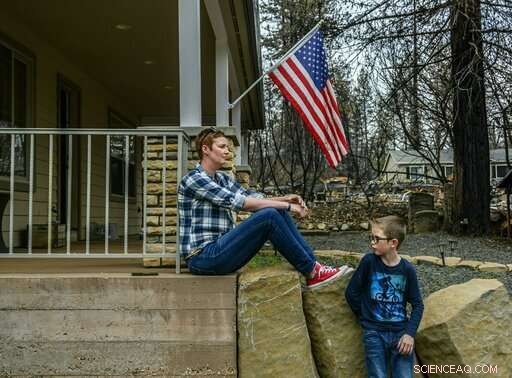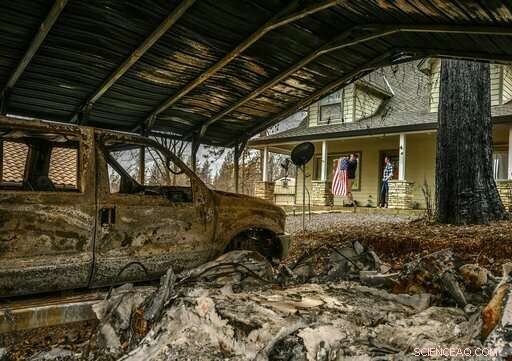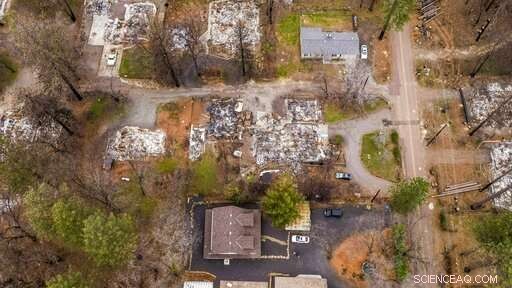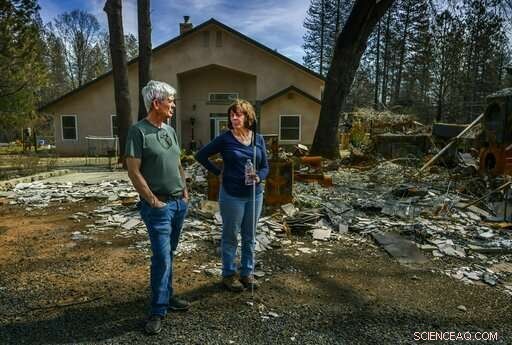
På den här bilden tagen 19 mars, 2019, Dawn Herr och hennes son Liam, 8, besöka deras hem i paradiset, Kalifornien, som överlevde lägerelden. Herrarnas hem, byggd 2010, blev svedd och fick rökskador inuti så familjen bor tillfälligt i närliggande Chico. Herrarna krediterar hemmets överlevnad till strikta byggregler och till grus som omringade byggnaden och höll lågorna tillbaka. (Hector Amezcua/The Sacramento Bee via AP)
Himlen blev orange och glöden flög från lägerelden när Oney och Donna Carrell och Donnas pappa skyndade iväg från deras hem i Paradiset.
"Jag trodde, 'Åh, väl, huset är klart, "" sa Oney Carrell.
Några dagar senare, de lärde sig annat. Familjen Carrells hem överlevde den dödligaste och mest destruktiva skogsbranden i Kaliforniens historia med ett par skeva fönsterramar, en delvis förkolnad dunpip och en envis röklukt inuti.
Det mesta av deras grannskap förstördes. Ett pensionat i deras bakgård, där Donnas far bodde, lades i aska, tillsammans med ett par skjul. Ändå satt deras vackert restaurerade Studebaker från 1940 orörd i garaget.
Förstörelsebågen som lägerelden ristade genom paradiset var till synes slumpmässig:Varför räddades vissa hus och andra brändes? När miljontals kalifornier rustar sig för ännu en säsong för skogsbränder, en McClatchy-analys av brand- och egendomsregister visar att svaret kan hittas i något så enkelt som taken över huvudet – och det år deras hus byggdes.
En landmärke från 2008 byggnorm designad för Kaliforniens brandbenägna regioner – som kräver brandsäkra tak, sidospår och andra skyddsåtgärder – verkar ha skyddat Carrells hem och dussintals andra gillar det från lägerelden. Det året markerar ett avgörande ögonblick i statens dödliga och dyra historia av destruktiva naturkatastrofer.
Allt sagt, cirka 51 procent av de 350 enfamiljshus som byggdes efter 2008 i vägen för lägerelden var oskadade, enligt McClatchys analys av Cal Fire-data och Butte County-egendomsregister. Däremot endast 18 procent av de 12, 100 hus byggda före 2008 klarade sig från skador. Dessa siffror inkluderar inte husbilar, som brann i nästan lika stor utsträckning oavsett ålder.
"Det här är bra standarder, de fungerar, " sade senior ingenjör Robert Raymer från California Building Industry Association, som samrådde med statliga tjänstemän om bygglagen.
Men trots denna lektion, Kalifornien kan komma att misslyckas i sina ansträngningar att skydda hem från nästa skogsbrand.
Svampstäder som Folsom, där en 11, 000-hus utveckling växer fram, har förmågan att kringgå statens säkerhetsstandarder trots betydande brandrisker. Staten, som erbjuder kontanta incitament för att stärka gamla hem mot jordbävningar, har hittills inte gjort något för att få kalifornier att bygga om hus byggda före 2008 för brandsäkerhet.
Det har inte hjälpt att bostadsbyggandet gick in i en djupdykning 2008 och har varit långsam med att återhämta sig. Raymer sa bara 860, 000 bostäder och lägenheter har byggts i hela landet sedan koden trädde i kraft. Det är bara 6 procent av statens bostadsbestånd.
Enligt Cal Fire, så många som 3 miljoner hem ligger inom de olika "brandriskzonerna" runt staten. Dave Sapsis, en Cal Fire vildmarksbrandforskare, sa att det inte finns något sätt att definitivt veta hur många av dessa hem som byggdes före 2008, men han tror "det är övervägande av dem, majoriteten."
Situationen är värre på landsbygden i Kalifornien, där bostadsbyggandet släpar efter men brandriskerna är bland de värsta i staten, sa Raymer. Färre än 3 procent av husen i vägen till lägerelden byggdes efter 2008.
"Det mesta av vårt lager som fanns här före branden var (byggt) mellan 40- och 70-talet, " sa Paradise Town Councilman Michael Zuccolillo, En mäklare. "Det genomsnittliga hemmet här var från 70-talet."
Det gör att tusentals hem hotas av nästa inferno över Kalifornien, deras trä-shake bältros väntar på att antändas.
"Vad ska vi göra åt det befintliga bostadsbeståndet som har byggts på dessa platser?" sa Max Moritz, en skogsbrandspecialist vid UC Santa Barbara. "För det befintliga bostadsbeståndet som finns där ute, som inte är byggd för dessa koder, vi har ett stort problem med eftermontering. De har strukturtändningssårbarheter som är inbyggda i situationen, de är inbakade i problemet."
"Den svagaste länken"
The Carrells, bor nu i en hyresrätt i Roseville, designade sitt hem i Paradiset och gjorde mycket av inredningsarbetet själva; de visste att hemmet byggdes med brandsäkerhet i åtanke.
"Jag visste att vi var mitt i skogen, " sa Oney Carrell under ett besök i Paradise nyligen. "Varför skulle du inte göra allt du kunde för att få det att hålla?"
Men även han är förvånad över att deras hem klarade det. Att kliva över en svärtad uteplatsavlopp bara några meter från baksidan av huset, undrade han högt:"Jag vet inte varför det stannade här."
Det är nästan omöjligt att med säkerhet säga varför vissa hem fortfarande står i paradiset, medan andra förstördes. Landskapsarkitektur spelade säkert en roll; brandexperter säger att hem som buffrats av så kallat "försvarbart utrymme" förmodligen klarade sig bättre än de som var insvept i buskar. Tur var en stor faktor, för, eftersom hem utan tvekan skonades av skiftningar i sista sekunden i vindarna.
Ändå, experter säger, McClatchys analys förstärker deras övertygelse om att Kaliforniens brandsäkra byggregler kan göra skillnad i en tid av ökande sårbarhet. Daniel Gorham, en före detta brandman och forskare från U.S. Forest Service som arbetar för Insurance Institute for Business &Home Safety i South Carolina, sade Kaliforniens kod håller på att bli en modell för andra brandbenägna stater.
"Kalifornien ligger med stormsteg före andra delar av landet, Gorham sa. "Kalifornien ligger i framkant."
Förespråkare säger att brandsäkra byggmaterial inte är särskilt dyra. En studie i höstas av Headwater Economics, ett konsultföretag i Bozeman, Mont., fann att "ett nytt hem byggt enligt koder som är brandsäkra kan byggas för ungefär samma kostnad som ett typiskt hem."

I denna 19 mars, 2019, Sean och Dawn Herr samlar en amerikansk flagga som överlevde lägerelden tillsammans med deras paradis, Kalifornien, Hem. Herrarnas hem, byggd 2010, blev svedd och fick rökskador inuti så familjen bor på obestämd tid i närliggande Chico. The Herrs credit the home's survival to strict building codes and to gravel that encircled the building and kept the flames back. (Hector Amezcua/The Sacramento Bee via AP)
But getting Californians to retrofit homes built before 2008 is an enormous task. The state requires property owners in fire zones who replace at least half their roof to install "fire-retardant" materials on the entire roof. Other than that, dock, there's nothing forcing Californians to safeguard their existing homes against fire hazards.
A few California cities have taken matters into their own hands. 2008, the City Council in Big Bear Lake, a community of 5, 200 in San Bernardino County, passed an ordinance declaring wood shake shingle roofs "a severe fire hazard and danger" and ordered homeowners to replace them by 2012. Armed with state and federal grants, it offered cash incentives of up to $4, 500 apiece for new roofs.
Although the grant program has run out, "I can't think of the last time I saw a shake roof in Big Bear, " said Patrick Johnston, the city's chief building official.
Most Californians, dock, are on their own when it comes to spending the tens of thousands of dollars needed to replace a roof or install fire-resistant siding. The state offers no financial incentives for fire safety the way it does, säga, for earthquakes—homeowners in quake zones can get up to $3, 000 apiece from the state to gird their homes against seismic disaster.
There are signs, dock, that the state is beginning to get more serious about retrofitting homes for fire safety.
A law signed last year by former Gov. Jerry Brown requires the state fire marshal to develop a suggested list of "low-cost retrofits" by January 2020. The state would then promote these retrofits in its education and outreach efforts.
California also might start throwing cash at the problem.
A new bill, AB 38, introduced earlier this year by Democratic Assemblyman Jim Wood of Santa Rosa, would create a $1 billion "fire hardened homes revolving loan fund" to help homeowners retrofit their properties.
The issue is personal for Wood, a dentist who spent weeks helping identify victims from the Camp Fire and the wine country fires of October 2017. Although eligibility terms haven't been spelled out, the bill would offer low-interest and no-interest loans to help those who otherwise couldn't pay for new roofs or other safeguards.
"A lot of these small towns are not as well off financially, " he said. "We need to find a way to help them, especially if they're poorer."
The fund might not be nearly enough to go around—not with hundreds of thousands of homes in need of retrofits, and a new roof alone costing $10, 000 eller mer. "The $1 billion, verkligen, that's not enough to rehab every home, " said the Building Industry Association's Raymer. But he said it's "an absolutely excellent way to kick things off."
Wood said state officials would have to figure out a plan for parceling out the money to where it's needed most—probably starting with lower-income areas near forests.
"Obviously we want to affect the areas with the highest risk first, " the assemblyman said. "A lot of these small towns are not as well off financially. We need to find a way to help them, especially if they're poorer."
Mapping 'Severity Zones'
The fire-safe building code had its origins in two significant fires from a generation ago—the Panorama Fire of 1980, which spilled out of the mountains into the city of San Bernardino; and the monstrous Oakland Hills Fire of 1991, which wiped out 2, 500 homes and killed 25 people.
Som svar, the Legislature ordered the Department of Fire Protection and Forestry to start mapping major fire risks in California, in the hinterlands as well as urban areas. The result was a collection of maps of the state's "fire hazard severity zones, " encompassing more than one-third of California's land mass.
Based on factors such as terrain, vegetation and weather patterns, the zones represent Cal Fire's attempt to predict the probability of a fire starting and the likelihood that it could become significant, said Cal Fire's Sapsis.
The maps spawned tighter building standards. The Legislature mandated fire-resistant roofs in these fire-prone areas. Then in 2008 the state laid out a more comprehensive scheme. The California Building Standards Commission rolled out a suite of regulations, known as Chapter 7A, that set strict rules for roofing materials, siding, fönster, decks and other elements of a home built in 2008 or later—right down to the minimum specs for the wire mesh that must be installed on attic vents to keep embers out (no more than a quarter-inch of space between the wires).
Experts said the regulations seem to be particularly effective at protecting structures from the types of wildfires that are increasingly common in California, where wind gusts can blow embers a mile or two ahead of the main wall of flames and do some of the worst damage.
"A window breaks, a vent breaks, the fire gets into your home and you've got an interior structure fire, " said Joe Poire, the city of Santa Barbara's fire marshal.
Enforcement of the building code carries a few wrinkles. In the mainly rural areas where Cal Fire is in charge of fire protection, the Chapter 7A code is automatically enforced in any region that Cal Fire has designated as a "severity zone"—moderate, high or very high.
In urban areas that have their own fire departments, the code is generally used only in spots where Cal Fire says the threat is very high. Local governments have the discretion of rejecting the Cal Fire designation, and Sapsis said some city councils have been squeamish about the state's maps because of fears that the Chapter 7A code will inflate construction costs, or for other reasons.
Yet interviews with local officials throughout California by McClatchy indicate that the vast majority of cities and towns go along with Cal Fire's recommendations. Santa Barbara city officials extended the building code to coastal areas that had been overlooked by Cal Fire's mappers. The map omits small portions of Paradise, but the building code is enforced across the entire town, said Paradise public information officer Colette Curtis.

In this March 19, 2019 foto, an aerial image shows the home of Sean and Dawn Herr, bottom center, i paradiset, Calif. The Herr home, built in 2010 to new fire-resistant building standards, survived the fire while nearby homes burned. (Hector America/The Sacramento Bee via AP)
Danger In Santa Rosa, Folsom?
Ändå, there are places where local officials are reluctant to impose strict building codes—even where fire has caused catastrophe.
Before Paradise exploded, Santa Rosa's Coffey Park was the poster child for recent California wildfire disasters:Five people died and 1, 321 homes were destroyed by the Tubbs Fire in October 2017.
Coffey Park wasn't subject to California's Chapter 7A building code. It still isn't.
Unlike some areas of Santa Rosa, the neighborhood hasn't been designated a "very high fire hazard" zone by Cal Fire. City officials are OK with that. Although developers rebuilding Coffey Park are being urged to consider fire-resistant materials, city spokeswoman Adriane Mertens said the city doesn't see any reason to impose the 7A code in the neighborhood.
"There were very, very high winds that night, " Mertens said. "There were embers that were blown across the (Highway 101) freeway, across six lanes of freeway, into Coffey Park."
Jack Cohen, a fire scientist in Montana who helped develop the 7A code, said he thinks Santa Rosa is committing "an error in judgment" by rebuilding without the safeguards.
I vilket fall som helst, Cal Fire is updating its fire hazard maps over the next year or so, taking into account more sophisticated data on wind and other climate factors, and Sapsis said spots such as Coffey Park could wind up designated as high-risk areas. Once the maps are done, any region placed inside Cal Fire's "very high fire" zone will have no choice but to comply, under a bill signed into law by Brown last year.
But there will still be ways for cities to skirt the state building code.
Look at Folsom, widely considered one of the most vulnerable places in greater Sacramento to fire. The county's hazard mitigation plan says 44, 000 residents of Folsom are already at "moderate or higher wildfire risk."
Now the suburb is building a development called Folsom Ranch, eventually to be home to 25, 000 personer, on a parcel south of Highway 50.
The development is on land that used to be subject to the strict state building code. Now it isn't.
How did that happen? För flera år sedan, the land was outside Folsom's city limits and Cal Fire was responsible for its safety. Cal Fire's maps put the land in the "moderate" risk zone—a threat level high enough that, under the state's regulations, the fire-safe building code took effect. As it happened, no construction took place during that time, city officials say.
The situation changed when the city annexed the land to forge ahead with Folsom Ranch. Because the land has never been in the state's "very high" risk zone, the city feels comfortable letting Folsom Ranch develop without the Chapter 7A building code.
Fire Chief Felipe Rodriguez said Folsom officials are still open to "the possibility of strengthening, hardening, our future homes." But for now, the city is only requiring homeowners' associations to implement a "vegetation management" plan and install fire-resistant fencing around properties that abut open space areas, Rodriguez said.
Is Folsom courting danger? Rodriguez doesn't think so. The city will build two fire stations in the development and will "be able to suppress a fire during its early stages, " han sa.
'Sticks In A Fireplace'
The hundreds of thousands of older homes in fire zones aren't just more vulnerable in their own right.
Experts say they spread danger to new homes built to stricter standards.
"One little house built to a new standard, surrounded by a bunch of older stuff, is likely to get swamped, " Sapsis said.
Paradise provided a grim reminder of that problem. The Camp Fire destroyed more than 80 percent of the 4, 100 mobile homes in its path, whether they were built to the new code or not, according to McClatchy's data analysis. That isn't surprising, Sapsis said, given that many of Paradise's mobile homes were jammed alongside one another in mobile home parks.
"They're stacked so close together, they're like sticks in a fireplace, " Sapsis said.
Sapsis and others say the lesson is that strong building codes aren't enough. Särskilt, experts say communities must pay more attention to how they lay out their neighborhoods, allowing for firebreaks and enough space between houses.
"In the name of affordable housing, we're moving housing closer and closer to one another, " said Chris Dicus, a forestry and fire expert at Cal Poly, San Luis Obispo. "That serves to have house-to-house-to-house ignition."

In this March 19, 2019 foto, Oney and Donna Carrell stand near the ashes of her father's house in Paradise, Calif. Their property had two homes on it before the fire, but the only one to survive visible behind them was built to fire-resistant standards that went into effect in 2008. (Hector Amezcua/The Sacramento Bee via AP)
The problem isn't limited to densely-packed urban areas. "I live in a rural community, and I have got six feet basically separating me from my neighbor, " said Dicus, who lives outside of Morro Bay.
Dessutom, experts say California is struggling to enforce the state law regarding "defensible space" around properties.
The law requires that property owners maintain as much as 100 feet of defensible space around homes and other buildings in and around "a mountainous area, forest-covered lands, brush-covered lands, grass-covered lands, or land that is covered with flammable material." That means keeping trees and shrubs pruned and spaced far apart. Within five feet of the building, property owners are supposed to remove anything that could catch fire:mulch, växter, woodpiles and so on.
I praktiken, dock, enforcement of the defensible space law has been spotty at best. Raymer, of the California Building Industry Association, said most property owners don't understand how to maintain their yards. The state doesn't impose penalties for non-compliance, and only a few local governments have chosen to do so, Raymer said.
Legislation could change that. SB 190, by Sen. Bill Dodd, D-Napa, would require the state fire marshal to develop a "model defensible space program, " including penalties, that local governments could adopt.
The problem extends beyond homeowners' property lines. Gov. Gavin Newsom, finding some rare common ground with the Trump administration, is advocating for more aggressive management of forested lands.
A thinned forest northeast of Paradise provided one of the rare victories of the Camp Fire. As the fire raged out of the tiny community of Pulga, it essentially spared the northern part of Magalia. The reason was a series of forest-thinning projects conducted in recent years and overseen by the U.S. Forest Service, Sierra Pacific Industries and the volunteer Butte County Fire Safe Council. The council also worked diligently with area residents to clear brush from their property.
All that work "did exactly what we hoped it would do, " said Calli-Jane DeAnda, executive director of the council, which secured $1 million in grants to remove fuels from forested areas. "This investment of public money is so worth the effort."
The Paradise 'Lab Experiment'
The rebuilding of Paradise means thousands of homes are going to be constructed in the coming years to the stricter standards promulgated by the state in 2008. It represents the single largest test of the effectiveness of the building code.
"That is an absolute lab experiment for us, " Sapsis said.
On the streets of Paradise, fastän, community leaders are taking a more measured view. Zuccolillo, the town councilman, said asphalt roofs and stucco siding might "give us more of a chance" but he doubts they will guarantee Paradise's safety.
"I saw metal buildings, metal and stucco buildings, burn to the ground, " han sa.
Fortfarande, there's plenty of evidence, all over Paradise, that the state's building code can protect property.
The other day, Sean Herr pulled into his driveway on the west side of Paradise, where he and his wife Dawn were raising their two young children.
The first thing he did was bring out the ultimate symbol of resiliency:an American flag, the same one that flew on his front porch the day of the Camp Fire.
Like the flag, the house is still standing. The Herrs' home, built in 2010, suffered a bit of scorching and some interior smoke damage—the smoke is bad enough that they're still temporarily living in Chico and aren't certain they'll move back.
Fortfarande, they marvel at what a close call they had. A Ford Excursion and a boat parked in the front yard, just a few feet from their porch, förstördes. Five motorcycles locked in a shed behind the house got ruined. Most of their neighborhood is gone.
The Herrs believe their attention to defensible space—the house is mostly encircled in gravel—and the strictness of the building code probably made the difference.
"Our yard and the construction of the house saved it for sure, " Dawn Herr said, gesturing to a small scorch mark by the side of the house. "You can see it tried to catch on fire."
© 2019 Associated Press. Alla rättigheter förbehållna.